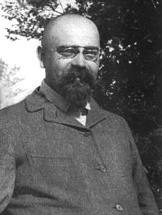The Gurdjieff Legacy Foundation Archives
Leonid Stjoernval (alt. Stjernvall, de Stjernvall) (1872—1938)

Leonid Stjoernval was born April 26, 1872, in Moscow, the son of Gustav Alexander Robert Stjoernval and his second wife, Anna Oldecopp. He married Elizabeth (Grigorievna) Feodoshev (b. January 17, 1885, in St. Petersburg) on September 3, 1905, in Luga, Russia.1 Anna Butkovsky-Hewitt reported that she was much younger than he, however, "...none of us ever saw [her]."2 With his wife he raised her son, Nicholas de Val, who was known to be Gurdjieff's natural son.3 A noted medical doctor and psychologist in St. Petersburg, Stjoernval operated an electro-massage institute (or an electro-hydropathic sanatorium), the location of which is disputed.4 He died of cancer on April 2, 1938, in Sotteville, Normandy.
First meeting Gurdjieff in 1915, Stjoernval was one of the original six students who met with Gurdjieff every day at Phillipoff's café. When Thomas de Hartmann first met with his future teacher, Stjoernval was one of two men at the café with Gurdjieff. It was Stjoernval who, during a group meeting in Finland in 1916 at the home of one of his patients, exclaimed, "Yes! I believe that Georgi Ivanovitch is not less than Christ himself!"6
Mrs. Butkovsky-Hewitt, a member of the original St. Petersburg group, saw Stjoernval as quiet, pleasant, business-like, an unemotional man who, even in meetings, "...spoke well, but without displaying any excitement, in his level doctor's voice."7 When given a task by Gurdjieff to relate to the group a "true account of the very worst action they had ever done in their lives," it was "utterly painful" to hear the doctor's account. "Gurdjieff, listening, said nothing, but fixed him with such a piercing look that it stopped the doctor in the middle of a word. Then Gurdjieff said, 'Another time, doctor, you will be sincere, and recall these matters accurately.... Think it over.'" About this event, she noted, "It was not hypocrisy, but more duality: the duality between the man of everyday and the man who is beginning to discover within himself the things of which he was never before conscious."8
Dr. Stjoernval and his wife were key members of the group of students that Gurdjieff led between the two armies of the Russian revolution, the Red and White, and over the Caucasus to Tiflis. It was often Stjoernval who smoothed the group's way with the authorities. De Hartmann wrote, "On my return I learned that Mr. Gurdjieff had, as usual, sent the doctor to get a White Russian pass for us," and again, "and when Dr Stjoernval went to the officials with our documents, we were let through without any difficulty."9 Later, Stjoernval went to speak with the higher government officials in Tiflis regarding a building in which to establish the Institute, being an "expert negotiator."10
In the autumn of 1920, Gurdjieff opened a "Constantinople branch" of his Institute. Dr. Stjoernval was noted as an instructor of medical gymnastics. And indeed, a Swedish genealogical listing of descendants of the Finnish House of Nobility lists him as a Director of an institute of Rhythmic Gymnastics in Fontainebleau, France.11
When the Institute moved to Germany, Stjoernval and his wife went to Finland to liquidate their assets, returning with "a considerable sum of money for the Work."12 Along with A. R. Orage, he was sent to New York in 1924, ahead of Gurdjieff and the rest of the group, to begin the logistical and monetary preparations that would make the trip possible.
Following Gurdjieff's car accident, Stjoernval attended him in the hospital, and again upon his arrival back at the Prieuré. Though he is mentioned in accounts as being frequently alongside Gurdjieff, and even answering questions in meetings, he never led a group. One of the most devoted pupils, Stjoernval and his family remained students of Gurdjieff even following the dissolution of the Institute at the Prieuré. They then moved to Normandy, where Dr. Stjoernval and his wife lived the rest of their lives.
Notes
1. Eero Kojonen, ed., Genealogia Sursilliana (Helsinki: Weilin & Goos, 1971). Also, Tor Carpelan, Attartavlor for de pa Finlands Riddarhus inskirvna atterna (Helsinki: Frenckellska tryckeri ab, 1965), 1116-17.
2. Anna Butkovsky-Hewitt, With Gurdjieff in St. Petersburg and Paris (London: Routledge & Kegan Paul, 1978), 66.
3. Mary Ellen Korman, review of Daddy Gurdjieff: quelques souvenirs inédits, by Nicholas de Val, The Gurdjieff Journal, vol. 5, no. 19.
4. James Moore states it was Finland in his Gurdjieff: The Anatomy of a Myth (Rockport, MA: Element, 1991), 77, as does E. C. Bowyer in "New Cult: Forest Temple of Hard Work and Rough Food," London Daily News, Feb. 15, 1923, while the Genealogia Sursilliana states it was in St. Petersburg.
5. Butkovsky-Hewitt, 69-73.
6. Ibid., 67.
7. Ibid., 66.
8. Ibid, 68-69.
9. Thomas and Olga de Hartmann, Our Life with Mr. Gurdjieff, eds. T.C. Daly and T.A.G. Daly (London: Arkana/Penguin Books, 1992), 90-91.
10. Ibid., 142.
11. Carpelan.
12. De Hartmann, 163.